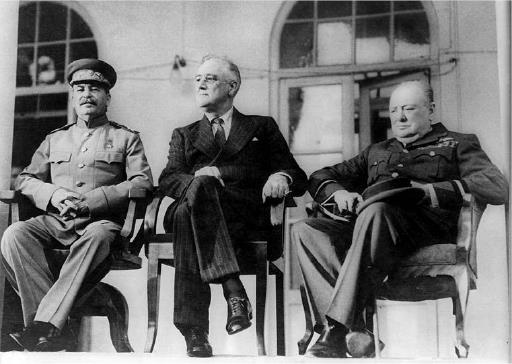Government and PoliticsUnited Nations |
How was the United Nations formed? |
Officially, the United Nations (UN) was not formed until October 1945. However, events during World War II (1939–45) had paved the way for the founding of the international peacekeeping organization that today is so familiar to people around the globe.
Fervent German nationalist Adolf Hitler (1889–1945) and his troops invaded Poland in 1939, and soon Nazi Germany had conquered much of Europe. Leaders of nine nations—Belgium, Czechoslovakia, France, Greece, Luxembourg, the Netherlands, Norway, Poland, and Yugoslavia—met with Britain and its Commonwealth states in London. There, on June 12, 1941, the countries signed the Inter-Allied Declaration, vowing to work together for a free world. Two months later, on August 14, U.S. president Franklin Delano Roosevelt (1882–1945) and British prime minister Winston Churchill (1874–1965) signed the Atlantic Charter. In it the two leaders outlined their aims for peace.
On January 1, 1942, the “declaration by the United Nations” was signed by 26 countries who pledged to work together to fight the Axis powers (Germany, Italy, and Japan), and they agreed not to make peace separately. The term United Nations, otherwise known as the UN, is believed to have originated with Roosevelt.
In late November and early December 1943, the Big Three—Roosevelt, Churchill, and Soviet premier Joseph Stalin (1879–1953)—met in Tehran, Iran, for the first time during the war. There these Allied nations leaders cited the responsibility of a United Nations organization in keeping the peace once the war was over. Though ending the war was first and foremost in the minds of these leaders, all had seen two world wars fought in close succession and were determined that the nations of the world could work together to prevent such an event from happening again. In August 1944, at the Dumbarton Oaks Conference in Washington, D.C., representatives of Britain, the United States, the Soviet Union, and China met to make plans for the peacekeeping organization that had been envisioned. The outcome of that meeting, which lasted into October, was the basic concept for the UN Security Council as we know it—with the world’s (five) major powers having permanent seats on the council and a limited and rotating membership beyond that.
When the Big Three met again at the Yalta Conference (in the Soviet Union) in February 1945, they discussed matters that were central to ending the fighting with Germany and with Japan. But Roosevelt, Churchill, and Stalin also announced that a conference of the United Nations would open in San Francisco on April 25 of that year.
Having directed the United States’ massive war effort, Roosevelt did not live to see the end of World War II or the creation of the international peacekeeping body. Roosevelt died suddenly on April 12, 1945. The war in Europe ended May 7. And during the closing days of World War II, the UN was chartered—the representatives of the Allied nations met as promised in San Francisco. On June 26, 1945, the governing treaty was signed by the delegates. On October 24, 1945, shortly after the war ended with Japan, the United Nations officially came into existence when the required number of nations approved the charter. Fifty nations were members of the UN at the outset; today the membership numbers 191.

